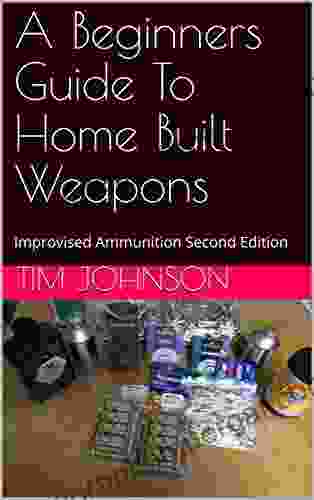The Ultimate Beginner's Guide to Home Built Weapons: Safety, Legality, and DIY Firearms

Disclaimer: The information contained in this article is for educational purposes only and should not be construed as legal advice. Before engaging in any activities related to home built weapons or firearms, it is essential to consult with qualified professionals and comply with all applicable laws and regulations.
5 out of 5
| Language | : | English |
| File size | : | 981 KB |
| Text-to-Speech | : | Enabled |
| Screen Reader | : | Supported |
| Enhanced typesetting | : | Enabled |
| Print length | : | 53 pages |
| Lending | : | Enabled |
Home built weapons and DIY firearms have been a part of human history for centuries. From the early days of muzzleloaders to the modern age of 3D printed guns, individuals have sought to create their own firearms for various reasons, including self-defense, hunting, and recreation.
However, building your own firearms comes with significant risks and responsibilities. It is crucial to approach this endeavor with the utmost caution and respect for safety and legality. This guide aims to provide a comprehensive overview of the subject, covering everything from materials and tools to assembly and testing.
Materials and Tools
The materials used in home built weapons vary greatly depending on the type of firearm being constructed. Common materials include:
- Metal: Steel, aluminum, and titanium are commonly used for firearms frames, barrels, and other components.
- Wood: Hardwood and plywood are used for gunstocks and other wooden parts.
- Polymer: Plastic polymers are becoming more popular for firearms components, offering durability and lightweight properties.
The tools required for home built weapons vary as well. Basic hand tools like screwdrivers, pliers, and wrenches are essential. Specialized tools such as a drill press, lathe, and milling machine may be necessary for more complex builds.
Safety Considerations
Safety is paramount when working with home built weapons and firearms. Always follow these guidelines:
- Wear appropriate safety gear, including eye protection, ear protection, and gloves.
- Work in a well-ventilated area, away from flammable or combustible materials.
- Handle firearms with care, always pointing them in a safe direction.
- Never work on a firearm that is loaded.
- Keep all firearms and ammunition stored securely when not in use.
Legal Considerations
The legality of home built weapons and DIY firearms varies greatly from jurisdiction to jurisdiction. It is essential to check the local and federal laws and regulations before engaging in any such activities.
In the United States, the Bureau of Alcohol, Tobacco, Firearms and Explosives (ATF) regulates the manufacture of firearms. Under the Gun Control Act of 1968, it is generally unlawful for any individual to manufacture a firearm without a federal firearms license (FFL).
There are some exceptions to this rule, however. Individuals may legally manufacture firearms for their own personal use if they do not have a specific intent to sell or distribute the firearms. They must also comply with all applicable state and local laws.
Assembly and Testing
Once the materials and tools have been acquired, it is time to assemble the firearm. This is a complex process that requires careful attention to detail. It is recommended to refer to a detailed guide or blueprint for the specific firearm being built.
Once the firearm is assembled, it must be tested to ensure it is functioning properly. This should be done in a safe environment, with proper safety precautions in place.
Home built weapons and DIY firearms can be a rewarding and educational experience. However, it is crucial to approach this endeavor with the utmost caution and respect for safety and legality. By following the guidelines outlined in this guide, individuals can safely and legally construct their own firearms for self-defense, hunting, or recreation.
5 out of 5
| Language | : | English |
| File size | : | 981 KB |
| Text-to-Speech | : | Enabled |
| Screen Reader | : | Supported |
| Enhanced typesetting | : | Enabled |
| Print length | : | 53 pages |
| Lending | : | Enabled |
Do you want to contribute by writing guest posts on this blog?
Please contact us and send us a resume of previous articles that you have written.
 Book
Book Novel
Novel Page
Page Chapter
Chapter Text
Text Story
Story Genre
Genre Reader
Reader Library
Library Paperback
Paperback E-book
E-book Magazine
Magazine Newspaper
Newspaper Paragraph
Paragraph Sentence
Sentence Bookmark
Bookmark Shelf
Shelf Glossary
Glossary Bibliography
Bibliography Foreword
Foreword Preface
Preface Synopsis
Synopsis Annotation
Annotation Footnote
Footnote Manuscript
Manuscript Scroll
Scroll Codex
Codex Tome
Tome Bestseller
Bestseller Classics
Classics Library card
Library card Narrative
Narrative Biography
Biography Autobiography
Autobiography Memoir
Memoir Reference
Reference Encyclopedia
Encyclopedia Jim Mattis
Jim Mattis Johanna Dobrich
Johanna Dobrich Joanna Hodge
Joanna Hodge Joel Stein
Joel Stein Joe Beam
Joe Beam Jeom Kee Paik
Jeom Kee Paik John Ankerberg
John Ankerberg Jenny Hale Pulsipher
Jenny Hale Pulsipher Jesse Durfee
Jesse Durfee Jennifer Jane Marshall
Jennifer Jane Marshall Jo Bradford
Jo Bradford Jim Fisher
Jim Fisher Jennifer Cole
Jennifer Cole John C Barrett
John C Barrett Jill Coil
Jill Coil Jeffrey Pepper Rodgers
Jeffrey Pepper Rodgers Jill Fitzgerald
Jill Fitzgerald Johan Blaauwendraad
Johan Blaauwendraad Jens Zimmermann
Jens Zimmermann Jim Barrow
Jim Barrow
Light bulbAdvertise smarter! Our strategic ad space ensures maximum exposure. Reserve your spot today!
 Gilbert CoxFollow ·14.6k
Gilbert CoxFollow ·14.6k E.E. CummingsFollow ·16.2k
E.E. CummingsFollow ·16.2k Cormac McCarthyFollow ·18.6k
Cormac McCarthyFollow ·18.6k Dean CoxFollow ·6k
Dean CoxFollow ·6k Samuel WardFollow ·14.7k
Samuel WardFollow ·14.7k Steve CarterFollow ·15.5k
Steve CarterFollow ·15.5k Nick TurnerFollow ·13.2k
Nick TurnerFollow ·13.2k Gabriel MistralFollow ·9.1k
Gabriel MistralFollow ·9.1k

 Christian Barnes
Christian BarnesUnleash Your Creativity: Build Interlocking 3D Animal and...
Discover the Art of Paper...

 Terry Bell
Terry BellUnveiling the Secrets of Winning: A Comprehensive Guide...
In the realm of chance and fortune, the...

 Albert Camus
Albert Camus101 Things That You Should Do Before Leaving The House In...
Starting your day right is...

 Anthony Burgess
Anthony BurgessForcing Move 2024 Volume: Unleash Your Inner Grandmaster
Embark on an extraordinary chess...
5 out of 5
| Language | : | English |
| File size | : | 981 KB |
| Text-to-Speech | : | Enabled |
| Screen Reader | : | Supported |
| Enhanced typesetting | : | Enabled |
| Print length | : | 53 pages |
| Lending | : | Enabled |
















